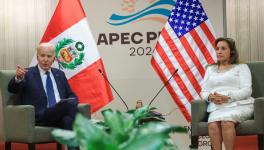Does India Truly Belong to SCO?

Russia will be hosting the 20th summit meeting of the Shanghai Cooperation Organisation in virtual format on November 10, 2020
The Shanghai Cooperation Organisation’s summit meeting on November 30 has a surreal setting. Being a ‘virtual’ meeting, the event spares the eight SCO statesmen of the embarrassment of having to accost each other or exchange pleasantries.
Imagine, India’s Prime Minister Narendra Modi having to sit across the table and risk eye contact with his Pakistani counterpart Imran Khan or Chinese President Xi Jinping! Fortuitously, the coronavirus pandemic has come to his rescue.
An even bigger embarrassment would have been Modi’s — if he had to host Imran Khan for the SCO’s Heads of Government Council meet which it will be India’s turn to host on November 30. In between, of course, comes that other pain in the neck for Modi — the 12th BRICS summit meeting on November 17. Again, Covid-19 precludes face-to-face meetings.
India has no enthusiasm for regional groupings of this sort in which the United States is not a participant. Now, the QUAD — that is where the Modi government’s tryst with destiny lies.
Yet, the SCO summit meeting on November 10 becomes a rare moment for Indian diplomacy. The SCO was originally a Chinese diplomatic initiative. And India is inch by inch suffocating it to death. Can there be a sweeter revenge for the Ladakh standoff?
The so-called “Shanghai spirit” is the core value of the SCO. It is about mutual trust, mutual benefit, equality, consultation, respect for cultural diversity and pursuit of common development among the SCO member countries.
But the Modi government gives a wide berth to “Shanghai spirit”. At least with two of the eight SCO members — founder-member China and next-door neighbour Pakistan — Modi government is barely on speaking terms. It lacks “mutual trust” with the governments led by Xi Jinping and Imran Khan.
The Modi government is not in the least interested in looking for a mutually beneficial relationship with either of these two countries. India harbours a seething rivalry vis-a-vis China and is determined to surpass it militarily and in the economic space some day in the future. As for Pakistan, India looks at it disdainfully as a failing state.
At any rate, India altogether rejects the idea of “common development” with either of these two countries unless they meet its pre-conditions. With Pakistan, Modi government is not even interested in holding any consultation. All that is to be discussed is the vacation of Indian territories illegally occupied by Pakistan.
But India’s real dilemma today is something else: Central Asia is not likely to be a major item in the Joe Biden administration’s agenda. The region remained important to the US so along as the American troops have been deployed to Afghanistan. With the US troop withdrawal, the importance of this region will go down for Washington. That would leave India in the lurch.
If only US secretary of state Mike Pompeo had continued in his job, he would have peered at the region through the Chinese lens even after the Afghan war ended. In fact, US-Indian policy coordination over Central Asia had shifted gear early this year, with an agenda to undermine the Chinese influence in the region.
This followed Pompeo’s Central Asian tour in February during which he held a meeting with foreign ministers from all five ex-Soviet Central Asian countries – Kazakhstan, Kyrgyzstan, Tajikistan, Turkmenistan and Uzbekistan.
Ahead of the visit, Pompeo openly acknowledged that the Central Asian countries on his itinerary “want to be sovereign and independent,” and Washington has “an important opportunity to help them achieve that.” He voiced disquiet that in the region there’s “a lot of activity – Chinese activity, Russian activity.”
Pompeo felt greatly distressed that the Central Asian states increasingly looked east to China’s trillion-dollar Belt and Road global trade plan as a panacea to treat their battered economies.
But Pompeo’s posturing in Central Asia met with very little enthusiasm, and had no open success. The mood in the region was succinctly captured by the Uzbek Foreign Minister Abdulaziz Kamilov, a veteran diplomat, when he told the American media that “we would really not like to feel on ourselves unfavourable political consequences in relation to some competition in our region between large powers.”
Pompeo finally got the point that given the specific geography of the Central Asian region, with the landlocked states being reliant on inbound pan-continental infrastructure investment from China as a means to propel their economic growth, the US stands hopelessly outplayed and outclassed. The Beijing newspaper China Daily was plainly contemptuous:
“The former CIA chief has been a fanatic in his attempts to smear China, outshining almost all his predecessors in this regard… Unless the US has the same commitment as China has in building connectivity and expanding win-win cooperation in Central Asia, Pompeo is simply wasting his time trying to undermine China’s interests there.”
Thus took shape the curious division of labour lately between South Block and Foggy Bottom, with Pompeo delegating the Central Asia desk to his Indian counterpart. It was smart thinking on Pompeo’s part to rope in India to undercut the SCO in Central Asia.
The External Affairs Minister S. Jaishankar duly chaired a meeting of the India-Central Asia Dialogue in the digital video-conference format on 28 October, which was curiously timed — one day after the US-India 2+2 Ministerial Dialogue and with barely ten days to go for the SCO summit.
Jaishankar made a grand announcement at the meeting about a US$ 1 billion [Rupees 7500 Crore] Indian Line of Credit for the region for “priority developmental projects in fields such as connectivity, energy, IT, healthcare, education, agriculture, etc.”
This episode in the hopeless US-Indian enterprise to try to undermine China’s influence in Inner Asia draws comparison with Modi’s announcement of a similar grand US$ 1 billion Indian Line of Credit to Mongolia during his visit to Ulaanbaatar in May 2015.
India has lost the plot in Central Asia. Central Asia’s economic growth largely depends on China. According to data from China’s customs service, in 2018, the trade turnover with the five Central Asian countries was in excess of $41.7 billion. According to data from the Chinese Ministry of Commerce, in 2018 the volume of direct investment in the five countries of Central Asia reached $14.7 billion.
More importantly, a large proportion of Chinese exports to Central Asia (more than 28 percent in 2018) are goods with a high added value — machines and equipment, electronics, and spare parts. The backbone of cooperation with China in the region is the Central Asia–China gas pipeline, which was, interestingly, built in 2009, much before the appearance of the Belt and Road initiative.
The main symbol of Chinese soft power is the Confucius Institute and its China studies classes. The organisation has 37 branches in Central Asia. Kazakhstan alone has 14000 students studying at five Confucius institutes. It is wrong to automatically view all of Beijing’s activity in Central Asia as part of the Belt and Road.
In Central Asia, India is not a consequential player. Having a format of cooperation with the region — Connect Central Asia — does not per se constitute a policy. India not only lacks a proactive policy in place, it barely reacts to events taking place there.
Does India belong to the SCO at all? China and some Central Asian states reportedly had misgivings about admitting India into the grouping in the first instance. They feared that India would slow down the dynamics of SCO cooperation.
But India’s “time-tested friend” Russia apparently thought otherwise. What mixed thoughts would be crossing the Russian mind tomorrow we will never know. After all, the Shanghai spirit was distilled out of the Sino-Russian normalisation after decades of rift.
Get the latest reports & analysis with people's perspective on Protests, movements & deep analytical videos, discussions of the current affairs in your Telegram app. Subscribe to NewsClick's Telegram channel & get Real-Time updates on stories, as they get published on our website.























